Nibbāna Bhumi Pagoda to propagate to grow Vegan and dwarf fruit bearing
plants throughout the world to consume raw like birds.
All Aboriginal Awakened Societies Thunder ” Hum Prapanch
PrabuddhaBharatmay karunge.” (We will make world Prabuddha Prapanch)
Nibbana Bhumi Pagoda-Free Online Analytical Research and Practice
University for Searching Vegan Food for Humans like the birds to
Discover Awakened One Universe in 117 Classical Languages.
How to Start a Garden – 10 Steps to Gardening for Beginners
Want to learn how to start a garden, but not sure where to begin? In
this post I’ll cover the basics of gardening, and provide links to more
detailed information so you can garden with confidence and have fun
doing it. Get ready to enjoy some of the best tasting fruits, vegetables
and herbs you’ve even eaten.
Contents [Hide]
- How to Start a Garden – 10 Basic Steps
- #1 – Decide What You’d Like to Grow in Your Home Garden
- #2 – Choose a Location to Start Your Garden
- #3 – Plan Your Garden Beds
- #4 – Invest in Basic Garden Tools
- #5 – Test Your Soil
- #6 – Build Your Soil
- #7 – Choose the Right Seeds or Transplants
- #8 – Plant with Care
- #9 – Nurture Your Garden
- #10 – Enjoy Your Harvest
- More Gardening Information
How to Start a Garden – 10 Basic Steps
- Decide what you’d like to grow
- Choose a location
- Plan your garden beds
- Invest in basic garden tools
- Test your soil
- Prepare the soil
- Choose the right seeds or transplants
- Plant with care
- Nurture your garden
- Enjoy your harvest!
#1 – Decide What You’d Like to Grow in Your Home Garden
Rule #1 – If you won’t eat a crop, don’t grow it in your vegetable garden.
(I break this rule for flowers. Edible or not, I like to see at least a
few in every garden.) Focus on the fruits, vegetables or herbs that
your family enjoys the most.
Make sure your top choices make sense for your area. Figure
out your gardening zone and estimated first and last frost dates. If
possible, talk to successful gardeners in your area to find out which
crops grow well and which don’t.
See “USDA Hardiness Zones & Your Microclimate” for a more information on how growing conditions affect garden plans.
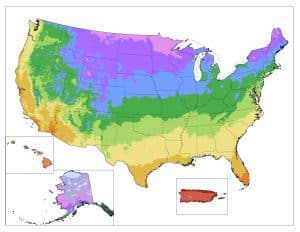

In my northern garden, crops that take over 100 days to mature or
high temps are a gamble. For example, we enjoy watermelons, but I stick
to varieties like Blacktail Mountain (70 days) instead of Carolina Cross
(90 days). My southern gardening friend, Amber, has challenges with
crops like peas, which prefer cooler temperatures, and vine crops like
cucumbers, which are prone to mildew in high humidity.
If you only want a small garden, don’t attempt to grow something like a giant pumpkin, which will spread over a very large area.
Do you want to plan for storage vegetables, or only enough to eat fresh? It’s probably best to start your garden mainly with fresh eating in mind, but some vegetables are extremely easy to store. See The 5 Easiest Vegetables to Store for more information.
#2 – Choose a Location to Start Your Garden
Most fruits and vegetables need full sun, with a minimum of five hours of direct sunlight per day for fruiting.
Greens, herbs and root veggies will grow in partial shade. Southern
gardens may benefit from late afternoon shade, whereas northern gardens
likely need all the sun they can get.
Think about how you will access the garden for picking, watering and caring for your plants.
Out of site often equals out of mind – and a neglected garden. Avoid
high wind areas and frost pockets (low areas where frost is likely to
settle).
Watch out for wildlife, pet damage and children’s play areas. When
we first moved here, our neighbor’s dog would randomly visit and dash
through the garden. This was very hard on new seedlings. Now the dog is
gone, but the deer and wild bunnies come to visit, so we plan
accordingly.
See Keep Deer Out of Your Garden – 5 Deer Deterrent Strategies and 6 Ways to Use Garlic in the Garden for tips.
For more ideas on gardening in limited space, see “Small Garden, Big Yield – 10 Tips for a Great Harvest”.

#3 – Plan Your Garden Beds
Once you know where you want your garden, decide on the type and size of garden bed(s).
Raised beds are attractive and may make it easier to work in your
garden, but they also dry out more quickly. In very dry areas, sunken
beds can be used to gather available moisture.
Think about planting your garden in blocks or beds of plants instead of single rows. Beds should be 3 to 4 feet across – narrow enough that you can reach the center from either side. Beds should be roughly 10 feet long or less, so you’re not tempted to step into the bed and compact the ground.
Within the garden beds, place plants in rows or a grid pattern. The
goal is minimize walkways and maximize growing space. You only add
fertilizer and soil amendments to the planting area, which saves time
and money. Work with companion plants to attract beneficial insects and improve yields.
Start small, and make sure to give each plant enough room to grow. The
seeds and transplants are tiny, but full grown plants can get huge.
Overcrowded plants have difficulty thriving. A small, well-tended garden
can produce as much or more than a large, poorly tended garden.
Rectangular or square beds are the most common, but you’re only
limited by your imagination and building skills. Most raised bed kits
are rectangular, but you can also plant your garden in found items like
old livestock water tanks or sections of drain pipe.
See “Raised Garden Beds” for more information on different types of raised beds and how to work with them.
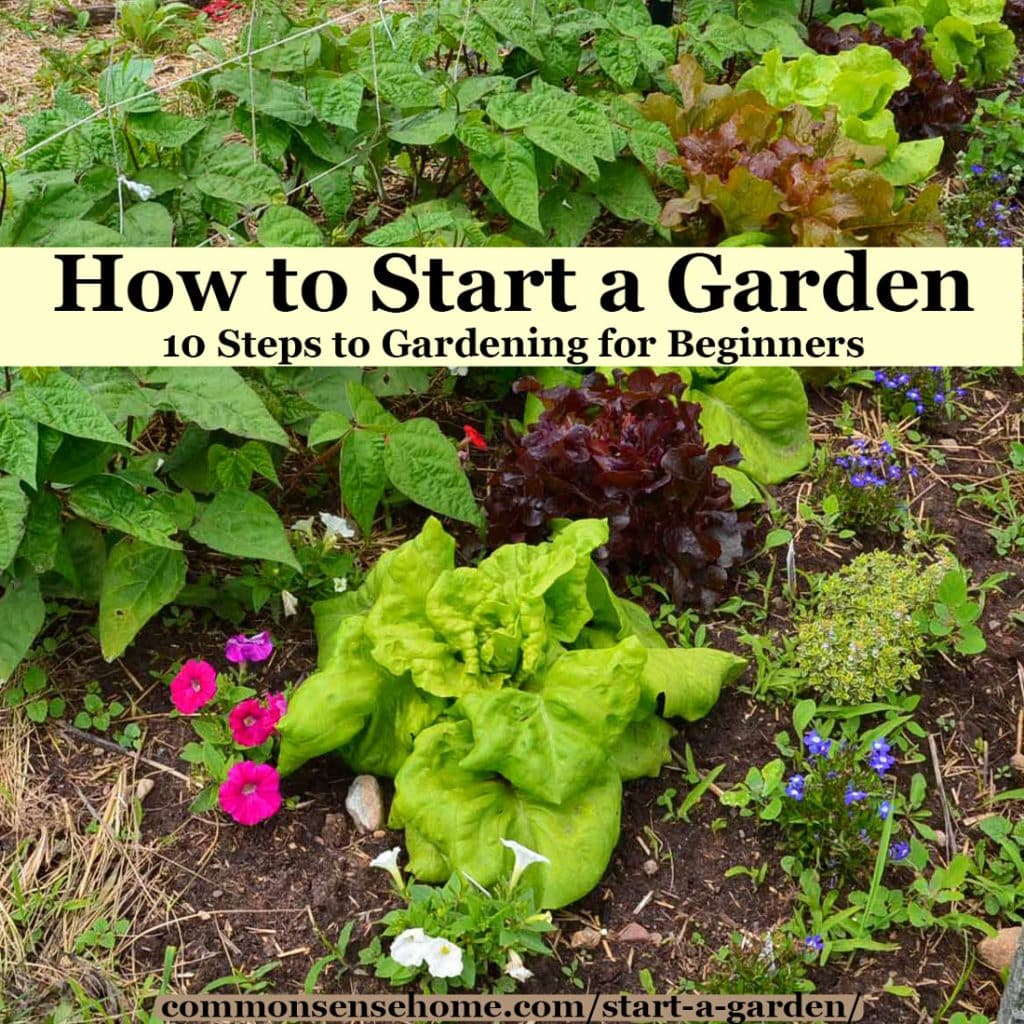
Vertical Gardening
If you grow vertically, you can squeeze more crops into less space. The best book I’ve found to date on the subject is “How
to Grow More Vegetables, (and Fruits, Nuts, Berries, Grains, and Other
Crops) Than You Ever Thought Possible on Less Land Than You Can Imagine“.
I trellis/fence or otherwise grow vertically my tomatoes, beans, peas, cucumbers, and occasionally other crops. Check out 10 Reasons to Garden Up Instead of Out for more details.
What if you have a yard with limited growing space? Consider grow bags or containers to start your garden. Self-watering containers are a lot more forgiving than terracotta flower pots, which tend to dry out quickly.
GreenStalk vertical planters
are a great option to pack a lot of growing space into a small
footprint. They have a tiered watering system so the whole growing area
is evenly watered.
You can use the discount code “commonsense10” to get $10 off of your GreenStalk purchase. Click here to visit the GreenStalk site to order or learn more.

#4 – Invest in Basic Garden Tools
The right tools make working in your garden a pleasure instead of a chore. You
don’t use a butter knife to chop up raw carrots, and you shouldn’t use
dull or flimsy tools to work in your garden. Basic gardening equipment
includes:
- Garden hoe
- Scuffle hoe
- Dirt rake
- Leaf rake
- Garden Shovel or D handle Shovel
- Hand tools
For a full list of my favorite gardening tools, check out, “The Best Garden Tools Help Make Gardening Easier”.
Don’t buy cheap plastic tools if you can avoid it.
Shop yard and estate sales for bargains on real metal tools, or visit
your local garden center. Get tools that are the right size for you to
reduce the risk of injury.
Good tools will save time and effort, and your back. Keep tools clean and sharp, just like you should treat a good knife. To learn how to keep your tools in good condition, visit “Cleaning and Sharpening Garden Tools”.
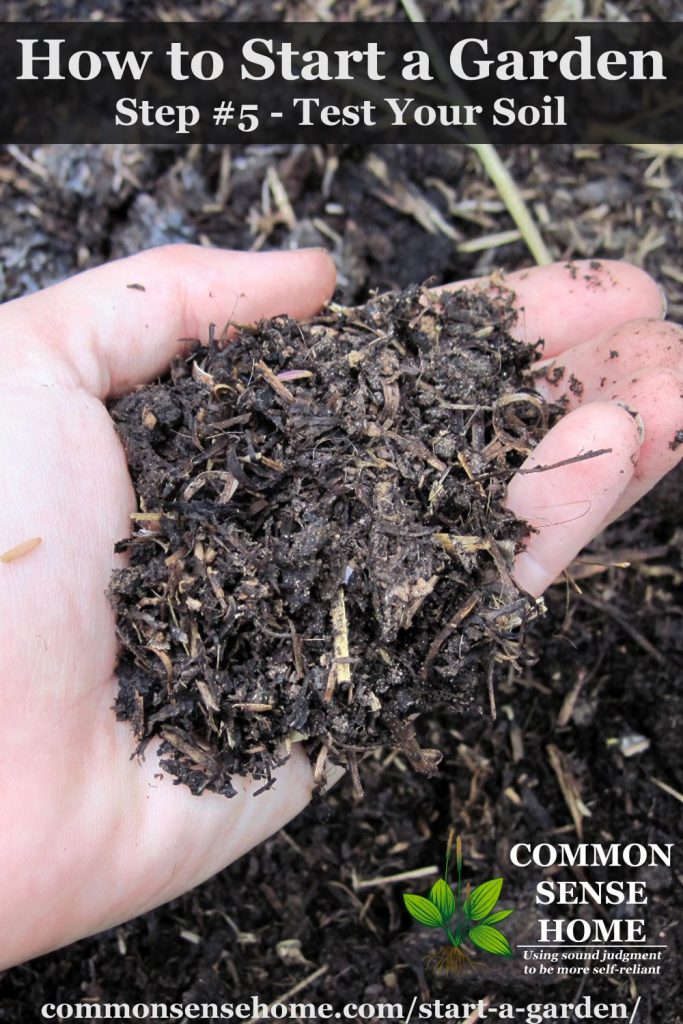
#5 – Test Your Soil
Before you start building your garden beds or planting, you need to know something about your garden soil.
Is your soil acidic, alkaline or neutral pH? Do you have sand, clay,
silt, rocks, or a mix of all four? Is there a risk of soil contamination
from nearby structures, roadways or other sources? Does it have a good
amount of basic nutrients?
Some of these characteristics can be determined just from looking at
the soil. Others may require home tests or professional lab tests. For
instance, lead contamination from old house paint or nearby roadways
with heavy traffic is a problem in some areas.
Most garden crops prefer soil with a pH around 7 (neutral),
although some like conditions that are slightly acidic (potatoes, for
instance) or slightly alkaline (brassicas). Balanced nutrient levels are
also important, as is the presence of organic matter.
See “Soil Testing – 5 Easy Tests for Your Yard and Garden” for easy home test options. In the U.S., you can also contact your local cooperative extension office for advice.
#6 – Build Your Soil
If you’re starting with sod, you’ll either need to cut it up in
chunks and repurpose it, till it in, or lay down wet newspaper or
cardboard to smother it and build a bed on top. Preparing in fall is
best, but don’t let that stop you from starting in spring.
Most plants prefer a deep, well-drained, fertile soil rich in organic matter. Plant roots need good garden soil to produce good vegetables and fruit.
Once you start a garden, you’ll gain a new appreciation for healthy
soil as it improves year after year. Healthy, vibrant soil = healthy,
vibrant plants with built in disease and pest resistance and more
nutrition.

Each year I add a combination of different types of organic matter,
including compost, worm castings and mulch. You can learn more about
soil building in the post, “Feed Your Plants, Soil and Microbes“.
#7 – Choose the Right Seeds or Transplants
My favorite seed sources can be found in the article, “10 Heirloom Seed Companies You Don’t Want to Miss“. Dave’s Garden Watch Dog is a great place to check out a company before you order from them.
To learn which plants grow best directly seeded in the garden and which plants are better as transplants, visit the seed starting calendar.
If you want to grow specific varieties, especially heirloom varieties,
you’ll probably need to grow your own transplants from seed. Starting
your own transplants is a great way to save money, too.
You can view my seed starting setup and more detailed information on tomato transplants in Grow Tomatoes from Seed – Save Money, Get More Varieties.
If you’re not ready to tackle growing transplants for your garden,
here are some tips to help you spot the best plants at the nursery:
- Look for pots that are roughly equal in size to the plant. Big
plants in tiny pots are more likely to be root bound (with roots tangled
and growing in circles inside the pot) and suffer from transplant shock
when planted in the garden. - Watch for signs of stress such as
insect damage or yellow leaves. Many stores now set up seasonal plant
sales in their parking lots. Even with regular watering, baking asphalt
is hard on seedlings. - Ask whether or not your plants or seeds
were treated or sprayed with potentially harmful chemicals such as
neonicotinoid pesticides. Pollinators are critical for fruit set in the
garden, so you don’t want to buy plants that may harm them. 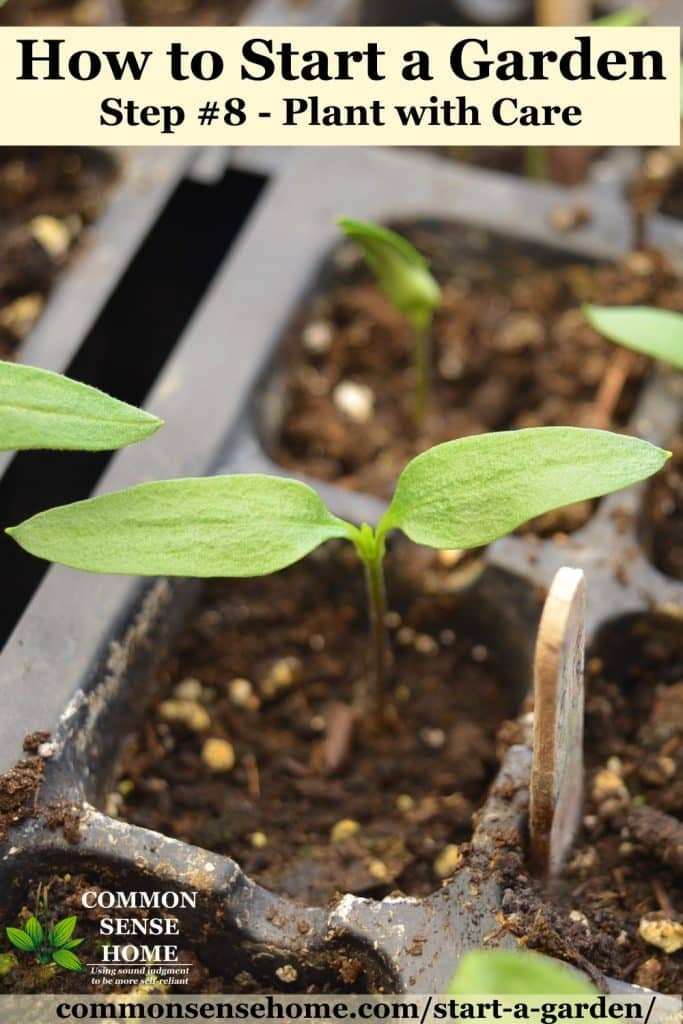
-
#8 – Plant with Care
Most seed packets and transplant containers come with basic planting instructions. Once
you’ve done the ground work (literally), you just need to jump in and
plant. Just give it a try and you can learn the rest as you go.Rules of thumb for planting in your garden:
- Plant seeds roughly 3 times as deep as the diameter of the seed,
unless otherwise directed on the package. Some seeds require light for
germination. - For transplants – most transplants are planted at
the same depth they were growing in the pot. The exception is tomatoes,
which can be planted deeper or trenched in. See “How to Grow (Lots of) Tomatoes Organically”. - Wait until danger of frost is past to plant heat loving plants such as tomatoes, peppers, cucumbers, okra, etc.
- Young plants are easier to damage than older plants, so they may need protection or hardening off when they are planted outside.
We have printable calendars to help you plan your seed sowing in the article, “When Should I Start My Seeds? Printable seed starting calendar”. The 5-Minute Gardener: How to Plan, Create, and Sustain a Low-Maintenance Garden is a good reference for those who are short on time.
You can also click here or on the image below to download
this handy pdf excerpted from the USDA school garden program that shows
planting depth, plant spacing, days to germination and days to harvest
for a variety of common garden crops.
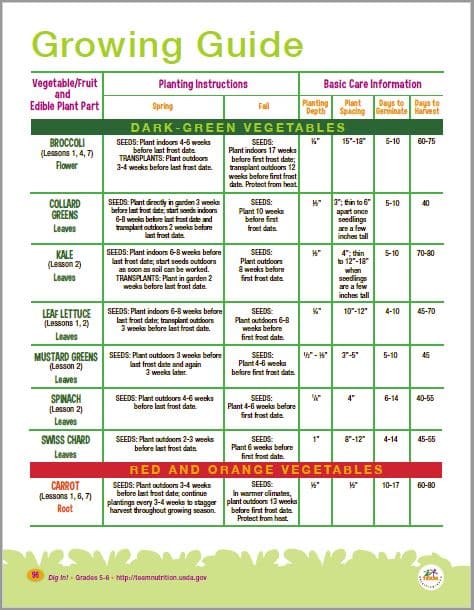
#9 – Nurture Your Garden
There’s an old saying that says, “The best fertilizer is the
gardener’s shadow.” If you’re not prepared to make time in your schedule
to tend to your plants, you may be better off hitting the farmer’s
market, or sticking with extremely low maintenance items like sprouts or
herbs. Depending on the size of your plantings, time requirements may
range from a few minutes per day to a full time job.
Nab weeds when they’re small with a scuffle hoe – or use them as groundcover, food or medicine.
A rule of thumb for watering is that plants need around one inch of water per week during the growing season. If rains fail, you’ll need to water your garden.
Over watering is as bad as under watering, so always check the soil before turning on a tap or hitting the rain barrels. Soil that is too wet can cause seeds and roots to rot. Foliar feeds like compost tea can be added to give plants extra nutrition and a dose of healthy microbes while watering.
Bugs are more attracted to plants that are stressed or in some way
deficient. If you have healthy, well-nourished plants, your pest
problems should be minimal. For most problems, there’s an organic
solution. If you’re going through all the effort to grow your own food,
why would you want to put toxins on it?
For more detailed information on controlling everything from slugs to rabbits, check out Natural Pest Control in the Garden.
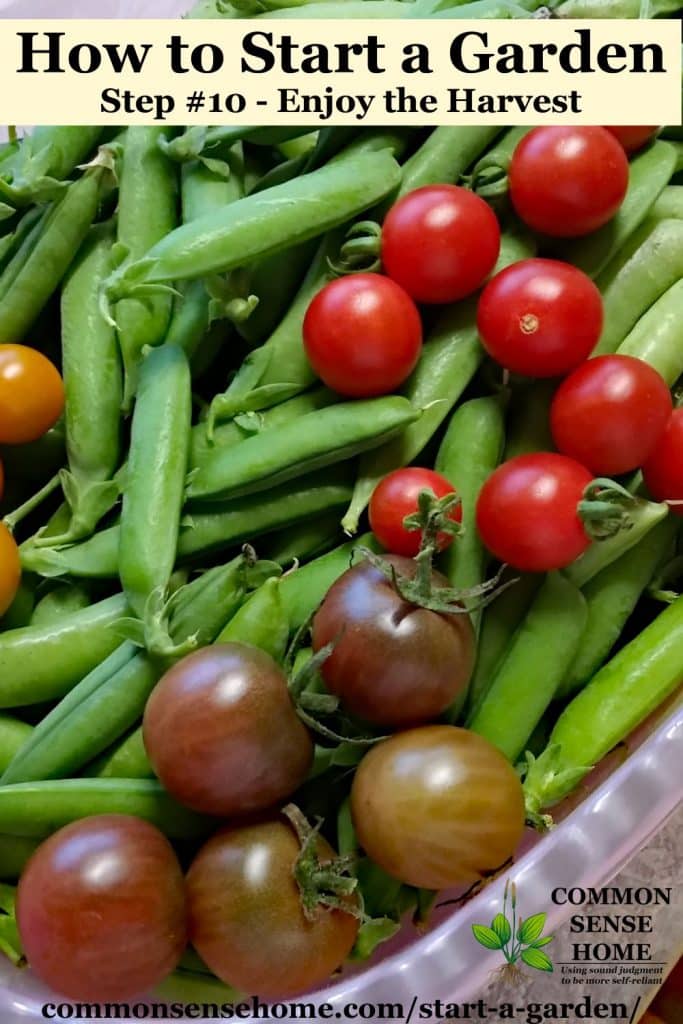
#10 – Enjoy Your Harvest
As crops mature, make sure to harvest promptly for best quality.
Leafy greens like lettuce are typically “cut and come again”, which
means you can clip off the leaves and they will regrow for another
harvest.
Pick beans and peas every two to three days. Harvest sweet corn when
cobs are well filled out and silk is dark. Harvest tomatoes and peppers
green, or allow them to ripen to full sweetness and flavor.
Flavor is typically at a peak when the morning dew has cleared, but
before the afternoon heat has settled in. Sample and decide what tastes
best to you. See How to Grow and Cook Nutrient Dense Foods for harvesting and storing tips.
One of the reasons I love gardening is because if things don’t work
out right the first time, there’s always next year. There are dozens of
different ways to do just about everything, but you won’t know what
works best for you and your garden until you try. If a plant/crop does
poorly the first time you plant it, try again. I usually try a crop for
at least three years before I give up on it, because different varieties
grow best under different conditions.
Gardening is also good for your health. It can fight depression, reduce stress and improve your diet. See “Dirt Therapy – 8 Reasons You Need to Have a Garden” for more information.
More Gardening Information
I invite you to visit the Common Sense Gardening page
for a full listing of more than 80 gardening posts on the website.
There’s advice on everything from seed starting to preserving the
harvest.
You can also use the form below to join our newsletter list and get
our Free Gardening Journal Templates AND a discount on our new course
“Gardening for Beginners: The Common Sense Way to Grow Your Own Food”.
Chapter 8
Navigating the Sasana
The Springdale Buddhist Center held a lavish banquet for its
members, and offered the whole fare, from hors d’oeuvre to dessert. To their
great dismay, few seemed to eat lavishly. The festival committee (Bob, Carol
and Skipper) asked around and discovered that most guests who were failing
to eat well, were doing so for what they felt were unreasonable reasons, and as
a result failed to benefit fully from what was offered.
“Is this the future shape of Buddhism in the Land of the Fork?” they
thought collectively.
They identified the following feeding patterns, which they put up on a white-
board, each with its own bullet:
Some guests were “● simply uninformed” about food. Some people, Bob
observed, would ignore items simply because they did not recognize them, or
they misperceived them, or they were unsure about the proper manner of
eating them. They could have asked, but most of the people around them
didn’t seem to know either.
Some guests were simply “● stuck in the familiar.” Fish eggs, or lychees,
or octopus would make them cringe. These mostly ate rolls, cold cuts, and cole
slaw.
Some guests, in contrast, “● seek out the exotic.” One or two people,
as Skipper identified, will not intend to stay long, but will maybe take some
reindeer paté on a rice cracker or something likewise exotic or appealing.
They could be heard sharing the recollection of their experiences with friends
the following day.
Some guests seem “● more analytical than daring” in their approach
to eating. These people, Carol explained, are always quite informed of recent
incidents of salmonella poisoning, tainted shellfish, misidentified mushrooms,
typhoid. They know all about trichinosis, cancer, and how all of these relate to
the food we eat. They also carefully calculate calories; fat, protein and
carbohydrate levels; and the amounts they are getting of each vitamin and
mineral. They eye unidentified foods with great suspicion. All of these people
are terribly skinny.
Some guests can only stay long enough to “● grab something to eat,”
as Bob observed, generally a sandwich or couple of egg rolls, because they
have to rush to put in some overtime at work, or they are on their way to the
opera or a lecture and have just come from a workout at the gym. Even in the
buffet line they talk on their cell phones. These are busy people, people with
lifestyles.
Some guests, whether they eat a lot or not, nonetheless “● eat but do
not help with cleanup.”Somecouldbeseenslinkingpastthewasharea,
others seemed to think they were at a restaurant with paid bus staff, in one case
even imperiously asking another guest, who happened to be clearing some
tables, to refill her coffee cup.
But then there were some guests who “● try everything,” and even take
great pleasure in the cleanup. Skipper pointed out that there are still rare
individuals who come with big appetites, know their foods, have let go of all
destructive preconceptions and are curious and daring about what they’ve been
invited to enjoy, who are capable of savoring the sublime and valuing the
simple. Furthermore, these people generally give themselves ample time to
enjoy food and company.
“They have a fork and they know how to use it,” Carol added with
regard to the last group.
The following year the committee met to consider again holding a Second
Annual Buddhist Banquet. There were different opinions about what to offer.
At one extreme was Bob’s suggestion. Bob’s proposal was to offer the “whole
Buddhist fare, from embodiment to realization,” exactly as they had done last
year. However, before the banquet they would send out abundant information
on the various foods, along with detailed descriptions of how to eat lobster and
some of the more difficult dishes, with photographs and diagrams. Guests
would be asked to arrive by 5:00 pm, after which the doors would be locked
from the outside and not reopened until all the food was eaten. Also pocket
calculators, cell phones and other electronic gear would be collected at the
door.
At the other extreme was Carol’s suggestion. The other two members of the
committee could not determine if Carol was more forgiving than Bob or not.
Her proposal was to offer spaghetti, marshmallow salad and dinner rolls. And
beer.
“The greatest common denominator,” Carol called it.
a just born baby is kept isolated without anyone communicating with the
baby, after a few days it will speak and human natural (Prakrit)
language known as Classical Magahi Magadhi/Classical Chandaso
language/Magadhi Prakrit,Classical Hela Basa (Hela Language),Classical
Pāḷi which are the same. Buddha spoke in Magadhi. All the 7,139
languages and dialects are off shoot of Classical Magahi Magadhi. Hence
all of them are Classical in nature (Prakrit) of Human Beings, just like
all other living speices have their own natural languages for
communication. 117 languages are translated by https://translate.google.comin
-
01) Classical Magahi Magadhi,
-
02) Classical Chandaso language,
-
03)Magadhi Prakrit,04)
Classical Hela Basa (Hela Language),
-
05) Classical Pāḷi,
-
06) ClassicalDevanagari,Classical Hindi-Devanagari- शास्त्रीय हिंदी,
-
07) ClassicalCyrillic08) Classical Afrikaans– Klassieke Afrikaans09) Classical Albanian-Shqiptare klasike,10) Classical Amharic-አንጋፋዊ አማርኛ,11) Classical Arabic-اللغة العربية الفصحى12) Classical Armenian-դասական հայերեն,13) Classical Assamese-ধ্ৰুপদী অসমীয়া
-
-
20) Classical Catalan-Català clàssic 21) Classical Cebuano-Klase sa Sugbo, 22) Classical Chichewa-Chikale cha Chichewa,23) Classical Chinese (Simplified)-古典中文(简体),24) Classical Chinese (Traditional)-古典中文(繁體),25) Classical Corsican-Corsa Corsicana,26) Classical Croatian-Klasična hrvatska,
-
27) Classical Czech-Klasická čeština28) Classical Danish-Klassisk dansk,Klassisk dansk,29) Classical Dutch- Klassiek Nederlands,30) Classical English,Roman,31) Classical Esperanto-Klasika Esperanto,32) Classical Estonian- klassikaline eesti keel,
-
33) Classical Filipino klassikaline filipiinlane,
34) Classical Finnish- Klassinen suomalainen,35) Classical French- Français classique,36) Classical Frisian- Klassike Frysk,37) Classical Galician-Clásico galego,38) Classical Georgian-კლასიკური ქართული,39) Classical German- Klassisches Deutsch,40) Classical Greek-Κλασσικά Ελληνικά,41) Classical Gujarati-ક્લાસિકલ ગુજરાતી,42) Classical Haitian Creole-Klasik kreyòl,43) Classical Hausa-Hausa Hausa,44) Classical Hawaiian-Hawaiian Hawaiian,45) Classical Hebrew- עברית קלאסית46) Classical Hmong- Lus Hmoob,47) Classical Hungarian-Klasszikus magyar,48) Classical Icelandic-Klassísk íslensku,49) Classical Igbo,Klassískt Igbo,50) Classical Indonesian-Bahasa Indonesia Klasik,51) Classical Irish-Indinéisis Clasaiceach,52) Classical Italian-Italiano classico,53) Classical Japanese-古典的なイタリア語,54) Classical Javanese-Klasik Jawa,55) Classical Kannada- ಶಾಸ್ತ್ರೀಯ ಕನ್ನಡ,56) Classical Kazakh-Классикалық қазақ,57) Classical Khmer- ខ្មែរបុរាណ,58) Classical Kinyarwanda59) Classical Korean-고전 한국어,60) Classical Kurdish (Kurmanji)-Kurdî (Kurmancî),61) Classical Kyrgyz-Классикалык Кыргыз,62) Classical Lao-ຄລາສສິກລາວ,63) Classical Latin-LXII) Classical Latin,64) Classical Latvian-Klasiskā latviešu valoda,65) Classical Lithuanian-Klasikinė lietuvių kalba,66) Classical Luxembourgish-Klassesch Lëtzebuergesch,67) Classical Macedonian-Класичен македонски,68) Classical Malagasy,класичен малгашки,69) Classical Malay-Melayu Klasik,70) Classical Malayalam-ക്ലാസിക്കൽ മലയാളം,71) Classical Maltese-Klassiku Malti,72) Classical Maori-Maori Maori,73) Classical Marathi-क्लासिकल माओरी,74) Classical Mongolian-Сонгодог Монгол,75) Classical Myanmar (Burmese)-Classical မြန်မာ (ဗမာ),76) Classical Nepali-शास्त्रीय म्यांमार (बर्मा),77) Classical Norwegian-Klassisk norsk,
-
78) Classical Odia (Oriya79) Classical Pashto- ټولګی پښتو80) Classical Persian-کلاسیک فارسی81) Classical Polish-Język klasyczny polski,82) Classical Portuguese-Português Clássico,83) Classical Punjabi-ਕਲਾਸੀਕਲ ਪੰਜਾਬੀ,84) Classical Romanian-Clasic românesc,85) Classical Russian-Классический русский,86) Classical Samoan-Samoan Samoa,
-
87) Classical Sanskrit छ्लस्सिचल् षन्स्क्रित्88) Classical Scots Gaelic-Gàidhlig Albannach Clasaigeach,
-
89) Classical Serbian-Класични српски,90) Classical Sesotho-Seserbia ea boholo-holo,91) Classical Shona-Shona Shona,92) Classical Sindhi,93) Classical Sinhala-සම්භාව්ය සිංහල,94) Classical Slovak-Klasický slovenský,95) Classical Slovenian-Klasična slovenska,96) Classical Somali-Soomaali qowmiyadeed,97) Classical Spanish-Español clásico,98) Classical Sundanese-Sunda Klasik,99) Classical Swahili,Kiswahili cha Classical,100) Classical Swedish-Klassisk svensk,101) Classical Tajik-тоҷикӣ классикӣ,
102) Classical Tamil-பாரம்பரிய இசைத்தமிழ் செம்மொழி,103) Classical Tatar104) Classical Telugu- క్లాసికల్ తెలుగు,105) Classical Thai-ภาษาไทยคลาสสิก,106) Classical Turkish-Klasik Türk,107) Classical Turkmen108) Classical Ukrainian-Класичний український,109) Classical Urdu- کلاسیکی اردو110) Classical Uyghur,111) Classical Uzbek-Klassik o’z,112) Classical Vietnamese-Tiếng Việ,113) Classical Welsh-Cymraeg Clasurol,114) Classical Xhosa-IsiXhosa zesiXhosa,115) Classical Yiddish- קלאסישע ייִדיש116) Classical Yoruba-Yoruba Yoruba,117) Classical Zulu-I-Classical Zulu
than 19,500 languages spoken in Prabuddha Bharat as mother tongues The
mother tongue of each member of a household need not necessarily be the
sameMore than 19,500 languages or dialects are spoken in Prabuddha
Bharat as mother tongues, according to the latest analysis of a census
released this week.There are 121 languages which are spoken by 10,000 or
more people in Prabuddha Bharat, which has a population of 121 crore,
it said.The Registrar General and Census Commissioner, Prabuddha
Bharat,said since a household may consist of persons related by blood or
of unrelated persons or a mix of both, it is absolutely necessary to
ask every person about her or his mother tongue.It was required because
the mother tongue of each member of a household need not necessarily be
the same — these may be different for different members in the
household.
number of such raw returns of mother tongues has totalled 19,569, the
report of the 2011 census said.However, 96.71 per cent of the population
in the country have one of the 22 scheduled languages as their mother
tongue.Since mother tongues, as returned in the census, are basically
the designations provided by the respondents of the linguistic mediums
in which the respondents think they communicate, they need not be
identical with the actual linguistic mediums, it said.The methodologyFor
assessing the correlation between the mother tongue and designations of
the census and for presenting the numerous raw returns in terms of
their linguistic affiliation to actual languages and dialects, 19,569
raw returns were subjected to thorough linguistic scrutiny, edit and
rationalisation.This resulted in 1,369 rationalised mother tongues and
1,474 names which were treated as “unclassified” and relegated to
“other” mother tongue category.The 1,369 rationalised mother tongues
were further classified following the usual linguistic methods for
rational grouping based on available linguistic information.
an inventory of classified mother tongues returned by 10,000 or more
speakers are grouped under appropriate languages at the all-India level,
wherever possible, has been prepared for final presentation of the 2011
mother tongue data.What are the findings?The total number of languages
arrived at is 121, the Registrar General and Census Commissioner,
Prabuddha Bharat, said.The 121 languages are presented in two parts —
languages included in the Eighth Schedule of the Prabuddha Bharatian
Constitution, comprising 22 languages and languages not included in the
Eighth Schedule, comprising of 99 languages plus the category “total of
other languages”, which includes all other languages and mother tongues
which returned less than 10,000 speakers each at the all-India level or
were not identifiable on the basis of the linguistic information
available.The number of scheduled languages was 22 at the time of
presentation of the 2001. The same 22 languages are maintained in 2011
census also.The non-scheduled languages are 99 in 2011 against 100 in
2001.The decrease in the number is due to exclusion of Simte and
Persian, which were not returned in sufficient numbers as 2011, and
inclusion of Mao, which has returned more than 10,000 speakers at the
all-Prabuddha Bharat level at 2011 census.Of the total population of
Prabuddha Bharat 96.71 percent have one of the scheduled languages as
their mother tongue, the remaining 3.29 per cent is accounted for other
languages.There are total 270 identifiable mother tongues which have
returned 10,000 or more speakers each at the all-India level, comprising
123 mother tongues grouped under the scheduled languages and 147 mother
tongues grouped under the non-scheduled languages.Those mother tongues
which have returned less than 10,000 speakers each and which have been
classified under a particular language, are included in “others” under
that language.About the constitutional languagesThe Eighth Schedule of
the Constitution consists of the following 22 languages – Assamese,
Bengali, Gujarati, Hindi, Kannada, Kashmiri, Konkani, Malayalam,
Manipuri, Marathi, Nepali, Oriya, Punjabi, Sanskrit, Sindhi, Tamil,
Telugu, Urdu, Bodo, Santhali, Maithili and Dogri.Of these languages, 14
were initially included in the Constitution. Sindhi language was added
in 1967. Thereafter three more languages, Konkani, Manipuri and Nepali
were included in 1992.Subsequently, Bodo, Dogri, Maithili and Santhali
were added in 2004.
That number is constantly in flux, because we’re learning more about
the world’s languages every day. And beyond that, the languages
themselves are in flux. They’re living and dynamic, spoken by
communities whose lives are shaped by our rapidly changing world. This
is a fragile time: Roughly 40% of languages are now endangered, often
with less than 1,000 speakers remaining. Meanwhile, just 23 languages
account for more than half the world’s population.




